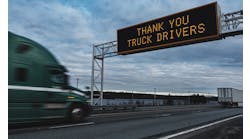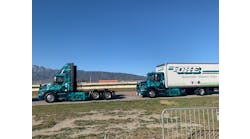Arguments over driver shortage, compensation are actually pretty similar
For a second consecutive year, the driver shortage and the hours-of-service (HOS) rules held the top two spots in the survey of top trucking industry issues conducted by the American Transportation Research Institute.
Motor carrier respondents indicated the shortage and driver retention were once again their top two issues. Rebecca Brewster, ATRI’s president and chief operating officer, offered some advice for those executives.
“If those are the issues you are concerned about then you better look at... the issues that drivers care about,” Brewster said in an interview during American Trucking Associations’ Management Conference & Exhibition. And among drivers, compensation easily topped the list of their critical concerns, resulting in that issue placing third on the overall 2019 survey.
Brewster said it is clear many drivers are concerned "their pay has not kept pace with inflation,” even after a year that saw some of the largest pay hikes in history. She added some motor carriers cited driver compensation as an industry challenge, but for slightly different reasons.
There is concern that with a softer economy, rates cannot keep up with those raises, “and you cannot walk back these pay increases.” Additionally, pay hikes from competitors had resulted in more job hopping among experienced drivers, Brewster explained.
Regardless of what the issues are called, ATRI said the top concerns are "two sides of the same challenge – the need for more drivers to meet the demand for freight."
Shortly after ATRI released the survey results, the Owner-Operator Independent Drivers Association sent out a press release saying that “we think it’s rather hypocritical for big trucking to keep saying there is a shortage when, according to the survey, the top concern of drivers isn’t even on their radar.”
That reaction wasn't all that much different to ATA’s extremely aggressive responses this past spring following the release - and related media coverage - of a study posted on the Department of Labor’s website claiming there is no driver shortage.
Others, however, feel the reality falls somewhere in between. For example, Lana Batts, co-president of DriverIQ, told Fleet Owner "if we were paying longhaul truck drivers $100,000 a year, we would not have a driver shortage. The problem is that assumes you can get the rates high enough to pay the $100,000."
She credited fleet executives for using freight rate increases to boost driver salaries. Yet, she felt it is ironic that private fleets such as Wal-Mart are able to pay drivers so much more than many of the for-hire fleets that have contracts to move freight for these same companies. It shows a "disconnect" between drivers and fleet executives, as well as those executives and shippers, Batts said.
A CLOSER LOOK AT THE 2019 SURVEY RESULTS
No. 1 - Driver Shortage
ATA estimates over 60,000 drivers are currently needed, and the shortfall could swell to 100,000 over the next five years. Bob Costello, ATA's senior economist, said while compensation is part of the solution, he is "convinced pay alone won't solve the problem." While survey respondents called for the development an apprenticeship program to attract those between the ages 18-20 into interstate trucking, this likely will only provide minimal relief in the near term.
No. 2 - Hours-of-Service
The HOS rules ranked as a top-three issue for both drivers and fleets in 2019, with much of the concern surrounding the desire for greater flexibility with the sleeper berth provision. The public comment period on the Federal Motor Carrier Safety Administration’s proposed HOS rules change ends on Oct. 21. Beyond that proposal, respondents called for looking at how HOS rules might be modified for highly automated trucks.
No. 3 - Driver Compensation
This year marked the first time the issue of compensation made the overall top 10 list. ATRI said it appears different pay models are expanding, and there is continued attention on quality-of-life issues that can play into how drivers view their overall compensation. A total of 8.3% of respondents listed compensation as the single biggest issue, slightly higher than even the HOS rules. Tied into the overall compensation picture includes a growing sense that drivers are not adequately compensated for non-driving duties such as detention wait times.
No. 4 - Detention / Delay at Customer Facilities
Another first-time entrant, the spotlight on detention time continues to grow, placing high among both drivers and motor carriers. Detention has “a direct nexus to many of the other issues among the top 10 including HOS, driver compensation, truck parking and the ELD mandate,” the report said. In a recent ATRI study drivers reported a 27.4% increase in delays of six or more hours between 2014-18. In total, detention costs drivers and carriers over $1 billion annually.
No. 5 - Truck Parking
Brewster’s tenure with ATRI began in 1993, and she told Fleet Owner undoubtedly parking would have been on the top 10 list, had it existed prior to 2005. “We’ve got to do something about this issue,” urged Brewster. She also reinforced a point made by Gary Helms, a driver with Covenant Transport, who said the parking problem is going to only get worse as the industry brings in more drivers.
No. 6 - Driver Retention
Retention slid three spots in 2018 as softer freight demand cooled the overall market. “Some attribute lower turnover rates to the driver pay increases many fleets have put in place to attract and retain qualified drivers,” ATRI wrote. Helms said many fleets need to do a better job preparing new entrants for the scope of the job, including simply "how to live on the road."
No. 7 - ELD Mandate
The December deadline for fleets to transition from automatic onboard recorders (AOBRDs) to ELDs has raised concern the supply chain could experience a productivity drop. James Reed, president and CEO of USA Truck, predicted it is "going to be a ripple, but certainly not a quake." The mandate topped the 2016 list ahead of the initial implementation in December 2017. Looking ahead, a majority of respondents indicated research is needed to more completely assess the impacts of ELDs on the industry, including the appropriate use of the data generated.
No. 8 - Compliance, Safety, Accountability (CSA)
CSA first appeared on the list in 2010 but continues to slide, in part because FMCSA announced plans in August to make its crash preventability determination program permanent. “However, the industry is still waiting to fully understand how CSA will perform – and rate motor carrier performance,” ATRI said.
No. 9 - Transportation Infrastructure, Congestion and Funding
The report points out "despite early indications that the Trump administration was going to focus on transportation infrastructure, the White House and Congress have yet to advance meaningful legislation to fund the nation’s roadways." ATRI research estimates that congestion-related delays increased the trucking industry’s fuel consumption by 6.87 billion gallons in 2016; adding an additional $15.74 billion to its fuel bill.
No. 10 - The Economy
A softer freight market, a trade war with China and the continued wait for ratification of the United States-Mexico-Canada Agreement (USMCA) are among the reasons the economy made this year’s list. Costello added the slowing global economy is another threat, but he does not "see a recession around the corner." Instead he projected a move back to "trend growth," though fleets that primarily rely on the spot market are likely to continue feeling more turbulence moving forward.
Emerging issues
Distracted driving, driver training standards and insurance costs/availability were the next three emerging issues on the overall 2019 survey.
About the Survey Methodology
There were 2,119 responses, an impressive 37% jump from 2018. Carriers represented 51.1% of respondents, with commercial drivers making up 35.3%, and other industry stakeholders making up the other 13.7%. Respondents ranked their top three choices from a list of 28 issues. The most important issue received three points, the second issue got two points and the issue ranked third receives one point. People can also write-in an issue. Brewster noted there were enough write-ins last year for “driver compensation” that it was added to this year’s listed issues.



